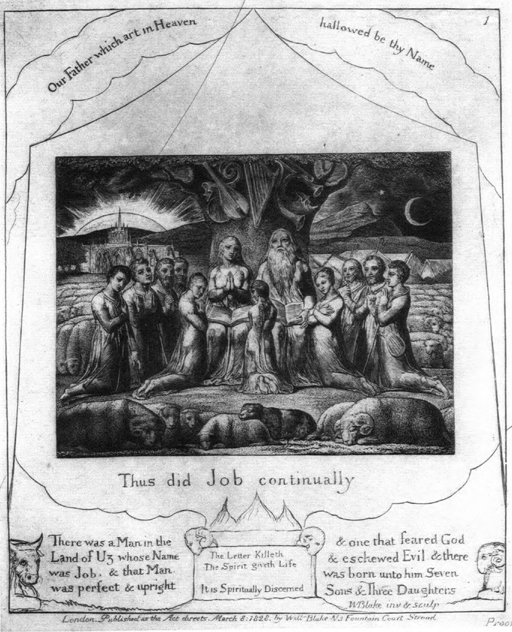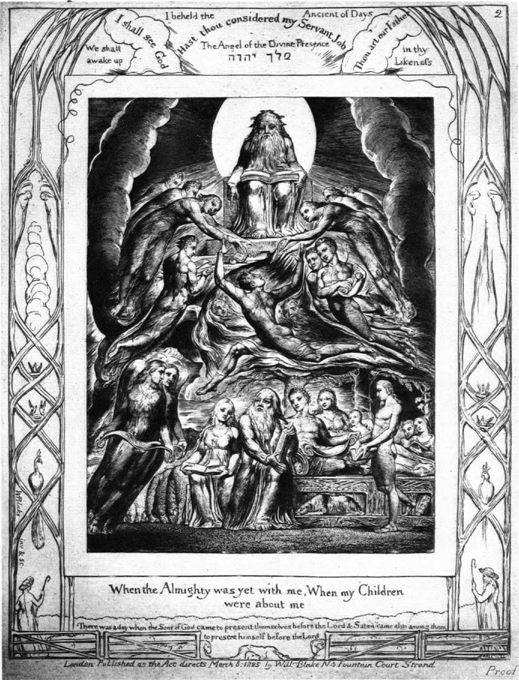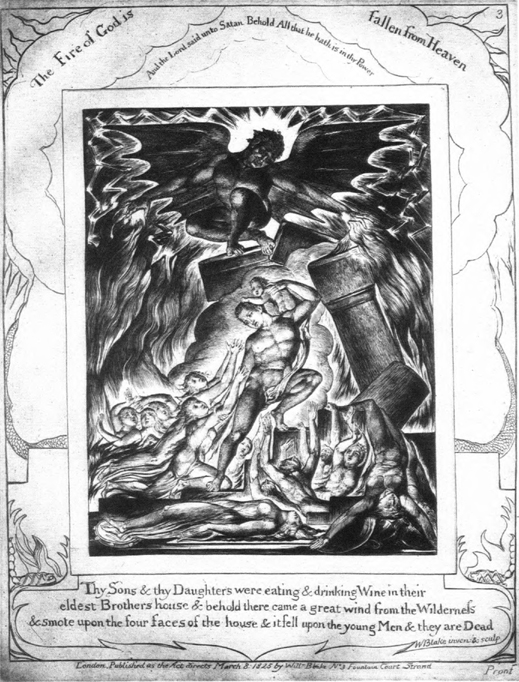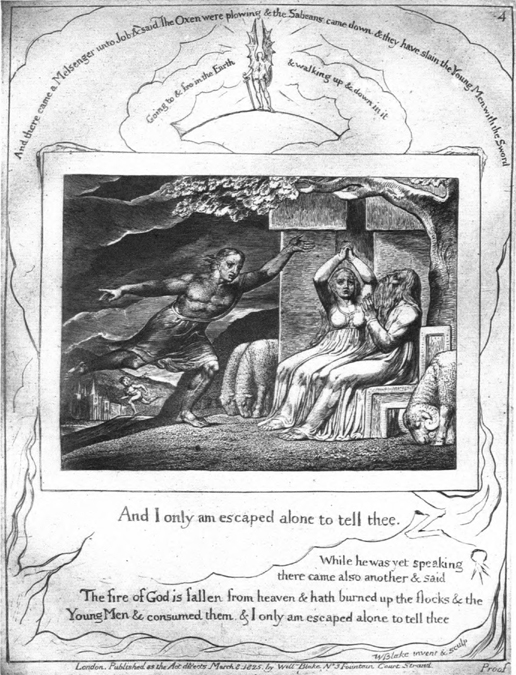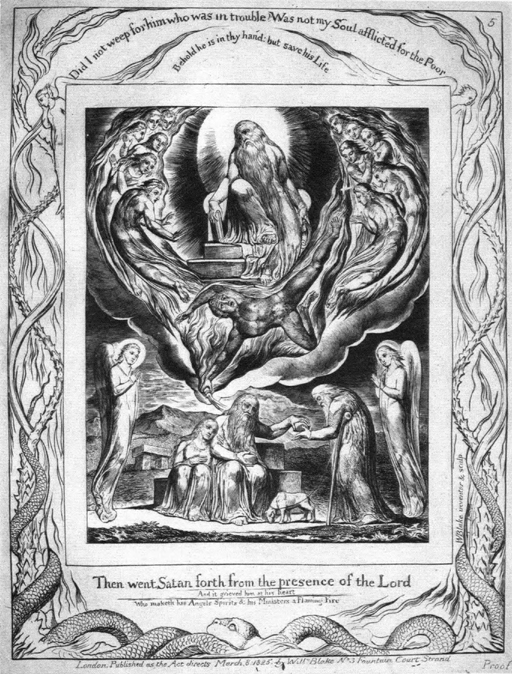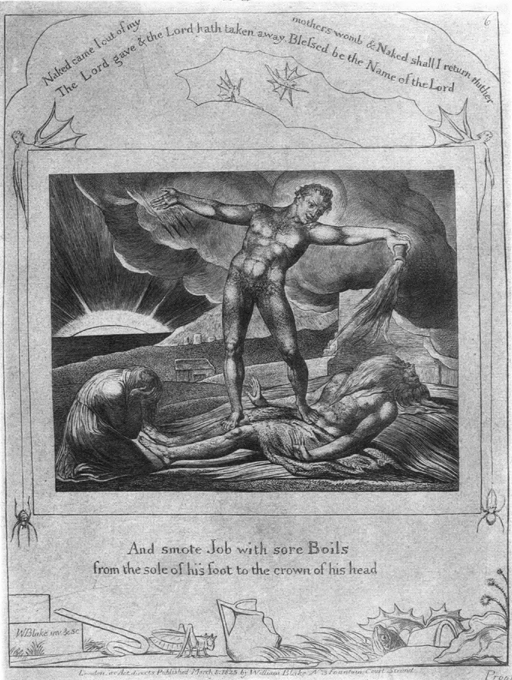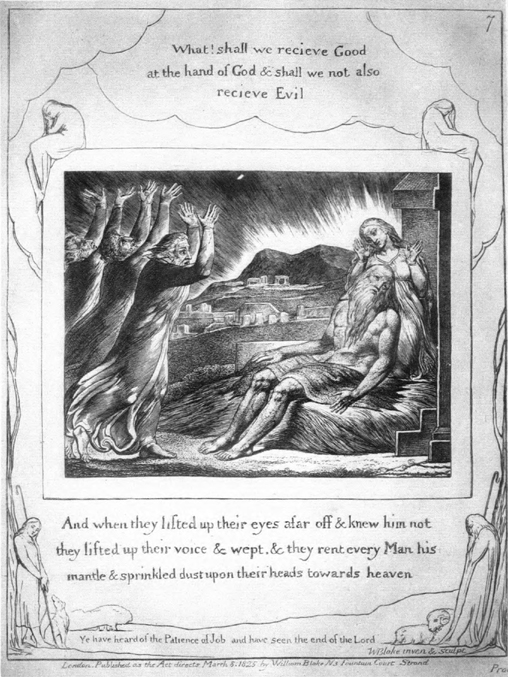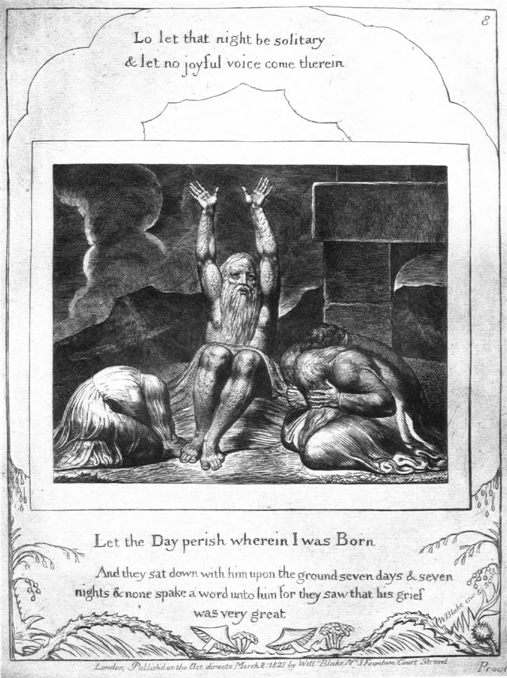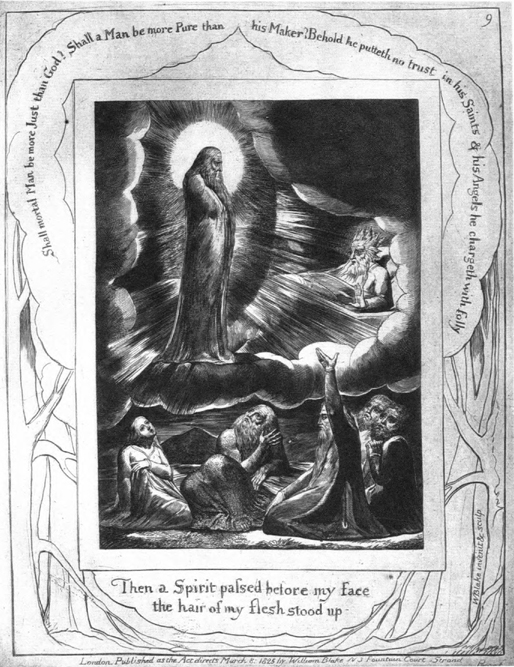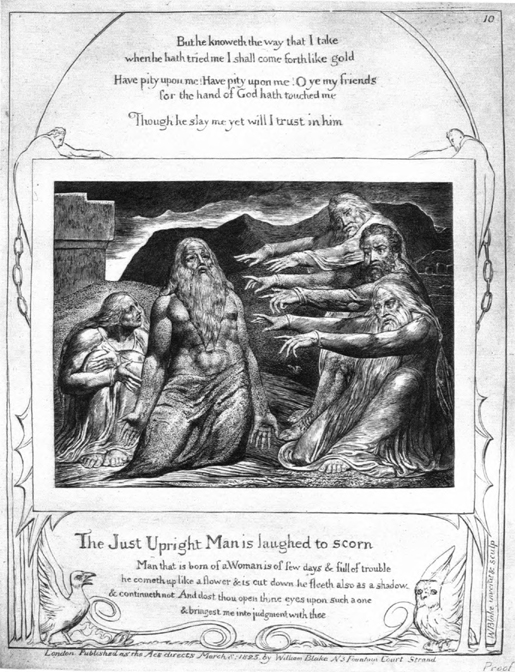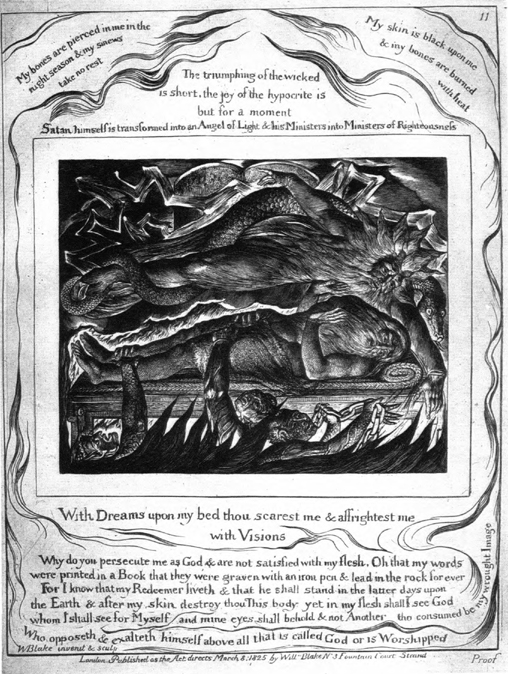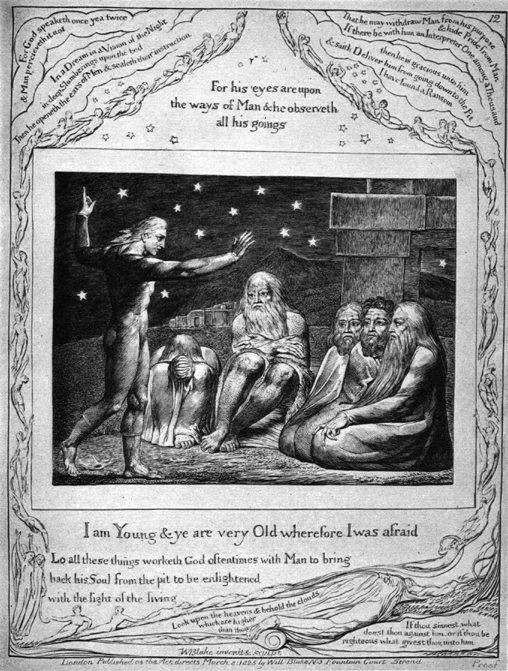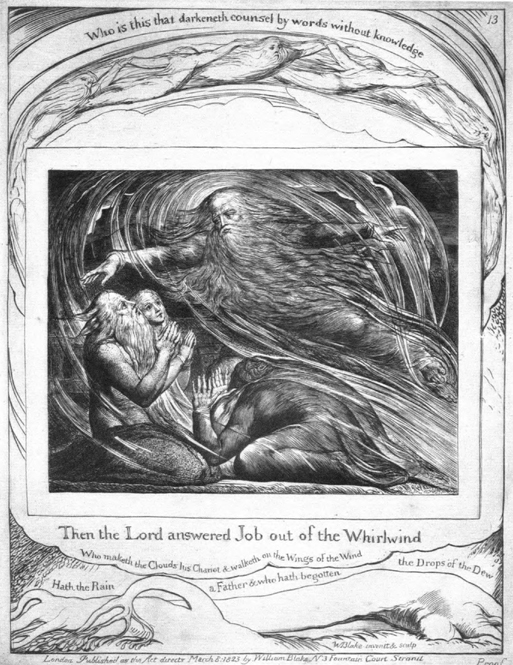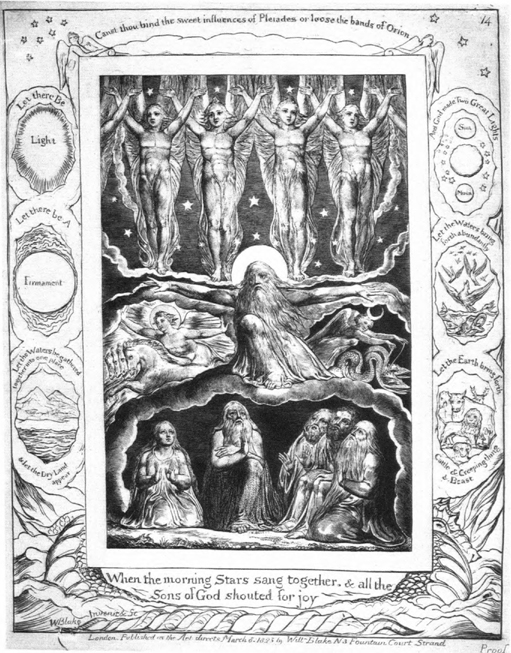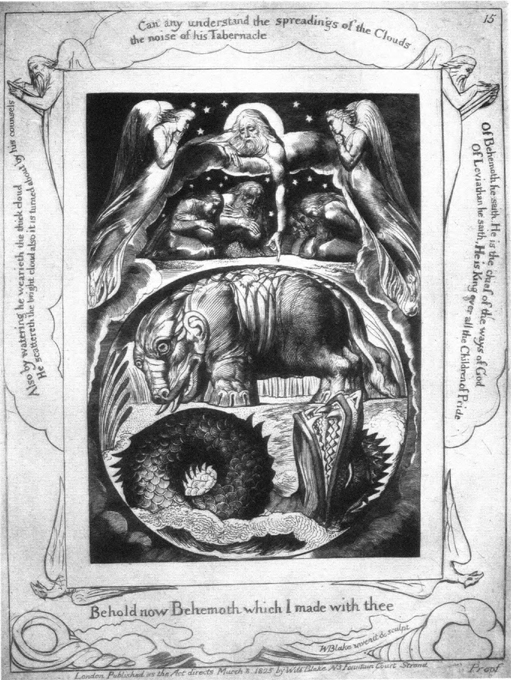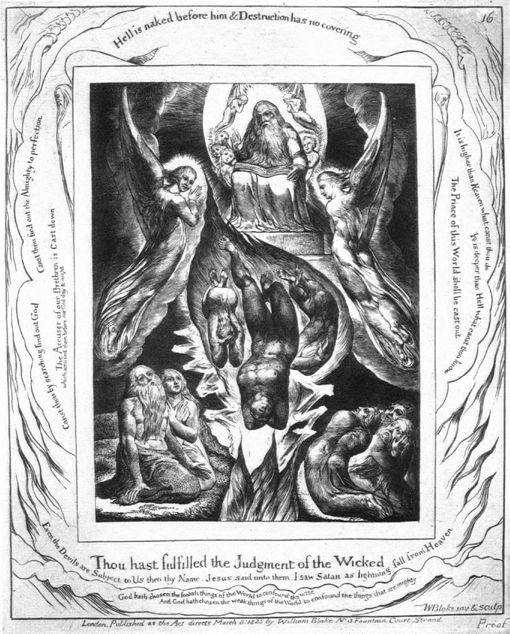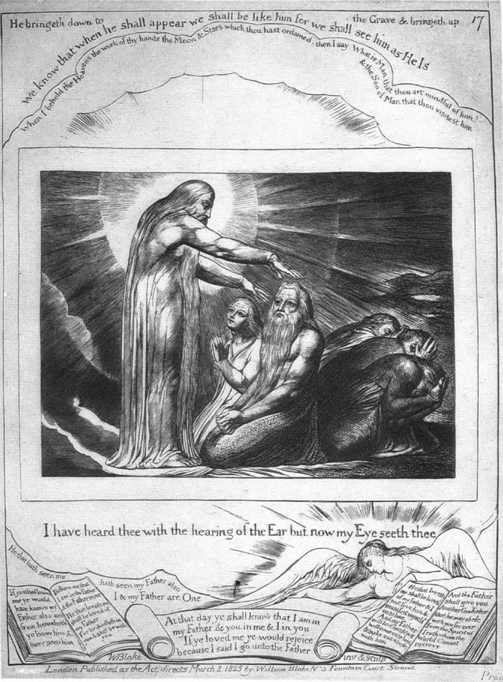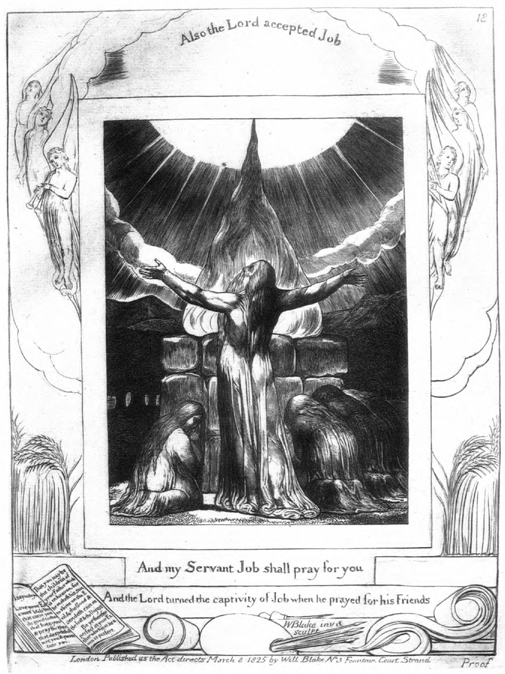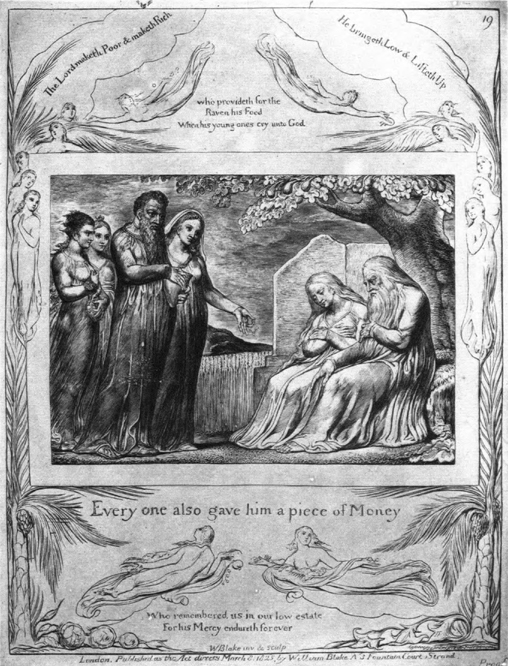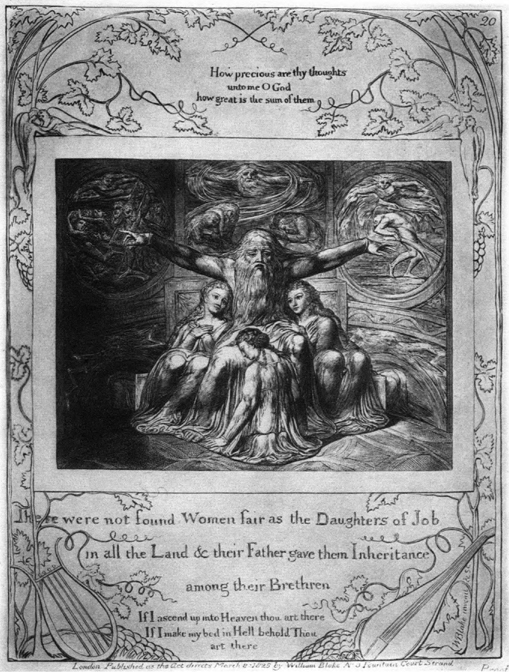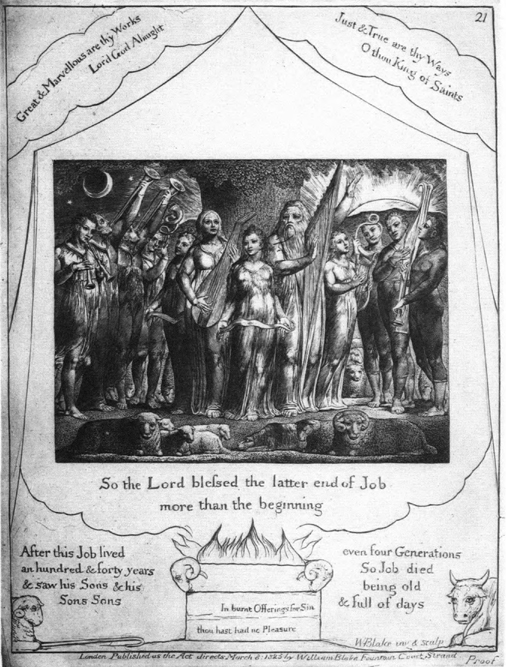WILLIAM BLAKE.
Edition: current; Page: [10]
Edition: current; Page: [11]
William Blake, poet, painter, visionary, was born in London in November, 1757. The conditions of his birth were prosaic. He was the second child of a respectable tradesman,—a hosier in small business, of whom, as well as of his wife, nothing is reported that accounts for the genius of his son by direct inheritance. Nature, however, so far as she affects the concerns of men, seems often to delight in working by a system of compensations and averages; and after the long reign of worldly wisdom in matters of intellect, that had lasted in England for two full generations, it was but to set even the balance of common sense and spiritual imagination to throw an overweight into the scale of the latter. Burns was born but fourteen months later than Blake; and we may take the ten years, from 1750 to 1760, as the beginning of that epoch of imagination in English literature and art which Blake and Burns, Scott, Coleridge, Wordsworth, Keats, Byron, and Turner have illustrated, and which, so long as Carlyle and Tennyson, Ruskin and Burne Jones, survive, has not reached its close.
It accords with this principle of compensation, to find Blake, the earliest in time of this galaxy, also the most opposed in spirit and genius to the prevailing intellectual tendencies of the preceding period, the most defiant of the popular taste in art, the most resolute in his assertion of individuality and independence.
He was, perhaps, fortunate in getting but little regular education: he was left much to himself, and he drank from springs deeper than any that flow through established schools. He was a meditative, dreaming, unsophisticated child. He loved to wander into the country; and, in later life, he was wont to relate, that one day, when, a mere child, he was at Edition: current; Page: [12] Peckham Rye, not far from Dulwich Hill, then a pretty rural region, he had his first vision, seeing a tree filled with angels; and on another summer morning he beheld angels walking in a field amid haymakers at work. Both the fact and the matter of these visions are characteristic. His whole life was filled with visions that appeared to him not mere subjective images of his own active and exalted fancy, but realized themselves to his perceptions as having actual existence and external reality. Angels continually visited him: asleep or awake he was familiar with their presence. And never was poet more susceptible to the sweet influences of rural nature, or harmonized them more completely with the pure life of angelic existences. Blake was essentially a poetic mystic, and his work is to be understood and fairly judged only so far as it is unreservedly accepted on its own terms. For the mystic assumes as divine the illuminations that dazzle and blind even when they enlighten. To him these revelations are above himself, and endow him with exceptional rights. A knowledge of spiritual things has been given to him, unattainable by the natural intellect,—a knowledge not to be questioned, doubted, analyzed, and made conformable to reason, but simply to be accepted and openly declared. This is no case for modesty: the man is but the instrument of the Spirit. That his visions appear childishness or folly to the worldly-wise is of little concern to him: the foolishness of God is wiser than men, and that which is revealed to him bears in itself its warrant and security. “He knows and tells, for he was present and privy to the appearance which he describes.” His conversation is with angels and spirits; and it is not strange that much of their talk should be as riddles to ordinary men.
But as Locke says, “When God makes a prophet he does not unmake a man;” so in spite of this deranged balance of Blake’s mind, by which his thought was overweighted with fancies, emblems, symbols, and confusions of spiritual essences with material forms, there remained to him, apart from all these, though intimately related to them, purity and simplicity of soul, force of character, steadiness of purpose, and a sweet, lyrical genius that found expression for itself in the two arts of poetry and painting.
His genius asserted its mastery from the first. His talent for drawing was so strong, even to his father’s eyes, that, before he was ten years old, he was “put to Mr. Pars’ drawing-school in the Strand,” a school thought well of at the time. His father, moreover, bought for him a few casts from antique models, that he might study from them at home, and gave him, from time to time, small sums of money to buy such prints as he might need. Even at this age the boy’s taste was true. “I am happy,” he wrote in later years, “I cannot say that Raffaelle ever was, from my earliest childhood, hidden from me. I saw and I knew immediately the difference between Raffaelle and Rubens.” That he was grateful for such teaching as he got, and that it did not hamper his natural gifts, may be inferred from his vigorous distich:—
- “Thank God, I never was sent to a school,
- To be flogged into following the style of a fool!”
Edition: current; Page: [13]
He wrote verses almost as soon as he began to draw; and a song, composed before he was fourteen, shows a freshness of fancy, a finish of expression, and a freedom from the mannerisms of verse then popular, surprising in the work of a child, and foretokening the rare originality and charm of his later poetry.
It was well for Blake that his father’s condition was not such as to allow him to grow up without some profession, by which he might earn his livelihood. The boy might be artist, but he must work for a living; and so, in 1771, when he was fourteen years old, he was apprenticed for seven years to a well-known engraver, James Basire, who is said to have been “a superior, liberal-minded man, ingenuous and upright, and a kind master.” His style as an engraver was hard and mechanical; but he was an exact and patient draughtsman, and he taught Blake the one essential requisite of good engraving, that of firm, determinate outline. Blake’s method of manipulation always remained simple, and was at times monotonous, lacking variety of resources for effect; but, in this special and fundamental quality of firm outline and deliberate drawing, he stands among the chief masters of engraving. The imaginative character of his designs is the source of the deepest interest of his work; but the mere student of the art of engraving will find in his best plates, such as the Illustrations of the Book of Job, examples of technical skill, and of fine drawing, which prove not only admirable training of hand and eye, but give evidence of the integrity of his moral nature. The stroke of his graver is both vigorous and tender: it is always sure and steady, however delicate. Fanciful as his conceptions may be, they are rendered with a distinctness that leaves no question of the clearness of the vision from which they proceeded, or of his power to express them with definite outline.
The earliest engraving that bears Blake’s name bears the date of 1773, the second year of his apprenticeship, when he was but sixteen years old. The design, and the inscription upon it, are both characteristic. It represents “Joseph of Arimathea among the Rocks of Albion.” At the foot of the plate it is said to be “from an old Italian drawing. Michel Angelo pinxit;” and then follow these words, showing the wild fancies which already beset the youth, and affording the first example of a style of epigraph employed by Blake on most of his later work: “This is One of the Gothic Artists who built the Cathedrals in what we call the Dark Ages, wandering about in sheep-skins and goat-skins; of whom the World was not worthy. Such were the Christians in all ages.”
Blake’s interest in Gothic architecture had been quickened by Basire’s employing him, during these years, to make drawings from the older monuments in Westminster Abbey, and other ancient churches in and near London, to be engraved for Gough’s “Sepulchral Monuments in Great Britain.” The occupation was well suited to the boy’s nature; and in the solitude of the dim aisles, in presence of the memorials of the famous dead of long-past generations, his imagination found motive and stimulus, and he saw visions as of old in the Edition: current; Page: [14] hayfields. His life, during his apprenticeship, seems to have been regular, industrious, and uneventful, with nothing to distinguish it externally from any common, dull existence. Yet its secluded, internal course was full of poetry; and the strong individuality of his genius, which made him solitary in the world, and set him apart from his generation, was defining itself to his own consciousness, and finding expression for itself in various forms, but especially in lyrics, such as for natural grace, sweetness, and melody, had not been heard in England for a hundred years and more. He had no pleasure in the faded poetry of his contemporaries, though he shared in the general admiration of Ossian, mistaking tumid shapes for grand forms, and misty vagueness for sublimity. He admired Ossian, he said long afterwards, “equally with any other poet whatever;” and the influence of Ossian on his own style is deplorably manifest in his prophetic books, and other mystical productions of his later years. By Chatterton he was greatly impressed; but his real masters in poetry were the best. Percy’s “Reliques,” which appeared in 1760, was one of his favorite books. He was a student of Shakspeare’s Songs and Sonnets, of Ben Jonson’s “Underwoods and Miscellanies;” but, above all, of the Bible, reading into it strange meanings of his own, interpreting it by the light of his private spiritual illuminations, and, in the course of time, shaping a creed out of it, in which gleams of fine spiritual insight appear in sharp contrast with meaningless obscurities, and truths of high moral significance are mingled with crude material fancies. But, in the compositions of these early years, there is comparatively little of the mystic and prophet. Written during his apprenticeship, they were collected and printed by the aid of friends in a thin volume, in 1783, when Blake was twenty-six years old. The title of the book is “Poetical Sketches, by W. B.;” and Mr. Rossetti says justly, “That, for formed style, and purely literary qualities. Blake, perhaps, never afterwards equalled the best things in this youthful volume, though he often did so in melody and feeling, and more than did so in depth of thought.” Nor was this surprising, considering his study at this time of the best models, and the fact, that, as time went on, he grew more and more absorbed in his personal spiritual experiences, and was less affected by external impressions. He had no training of the critical judgment; and the fine perceptions and native taste, which are manifest in his earlier productions, gradually ceased to exercise controlling influence over his work, as his imagination became more potent, and his self-confident genius claimed for itself an authority that he acknowledged as of supernatural validity.
His apprenticeship ended, he studied for a time in the Antique School of the recently established Royal Academy, then in charge of a Swiss decorative artist named Moser. From him Blake had little to learn. He drew from living models as well as from ancient statues, but he never mastered the human figure; and his design, however noble in conception, not infrequently exhibits, in some defect or eccentricity of form, the imperfection of his early training, and the influence upon his work of his theories of nature. But he had now to earn Edition: current; Page: [15] his livelihood, and it would have gone hard with him in London, had he had only his genius and his art to depend on. Engraving, pursued as a trade, furnished him with the means of subsistence. He found employment from the publishers, in engraving illustrations, mostly from the designs of other draughtsmen, for works such as the “Novelist’s Magazine,” or the “Lady’s Pocket Book,” or better, for Ritson’s “English Songs,” in the first volume of which are several vignettes engraved by him, from drawings by his friend Stothard. In August, 1782, when he was twenty-five years old, with happy confidence in the future, he married. The stock of his wife’s worldly goods was small enough; but she brought him a devoted spirit, and for forty-five years, till his death, which she did not long survive, she “uncomplainingly and helpfully shared his low and rugged fortunes,” and, bending her mind and soul to his, shared also his inner life, and aided in his work, not only with manual assistance, but with humble spiritual sympathy and unrelaxing faith.
The incidents of Blake’s external life for the few next years, and, indeed, for most of the years that follow, are of little importance, and afford scant illustration of the course and character of that poetic inner life, which separated him from all men in his generation. This life of the imagination was the only one of which he himself would have thought the events worth recording. Here was the real field of his activity. At this time its course was happy, if judged by its results. He was writing those “Songs of Innocence,” which, with the later “Songs of Experience,” have, in our generation, made his name dear and familiar to many who know nothing else of his work, and which will continue to be read by children, and by grown people susceptible to the charm of tender feeling, of childlike artlessness in subtle forms of art, of deep and delicate fancy, of a rhythm full of melody in which nature and art have equal share. Blake wrote and designed them at once: the poems were, in his conception, both verse and picture; and they lose their perfect charm in the divorce of the text from the illustration. This is to be remembered in reading, as we now for the most part are compelled to do, the verse alone.
Blake desired to get these poems published. He could be his own engraver, but he had not the means to pay printers’ bills. No publisher would venture on such an enterprise: there was no public for such poems. At length the difficulty was solved by a vision, in which Blake’s younger brother, Robert, to whom he had been closely attached, and who had lately died, appeared to him, and directed him to engrave text as well as illustration; pointing out to him the technical means by which a fac-simile of the whole poem, words and design, could be produced. The morning after this vision, “Mrs. Blake went out,” says Mr. Gilchrist, who tells the story, “Mrs. Blake went out with half a crown, all the money they had in the world, and of that laid out 1s. 10d., on the simple materials necessary for setting in practice the new revelation. Upon that investment of 1s. 10d. he started—what was to prove a principal means of support through his future life—the Edition: current; Page: [16] series of poems and writings, illustrated by colored plates, often highly finished by hand, which became the most efficient and durable means of revealing Blake’s genius to the world.” Blake’s method was a simple form of etching, by which the lines of text and design were left prominent, as in stereotype. From these copper plates he printed off the page in brown, yellow, or whatever color it might be, that might best serve as the ground tint for the colors, to be afterwards laid on by hand, in imitation of the original drawing. He ground and mixed his colors himself, on a piece of statuary marble. The colors he used were few and simple. He taught Mrs. Blake to take off the impressions with care and delicacy, and to help in tinting them from his drawings. “The size of the plates was small, for the sake of economizing copper; something under five inches by three. The number of the engraved pages, in the “Songs of Innocence,” was twenty-seven. They were done up in boards by Mrs. Blake’s hand, forming a small octavo; so that the poet and his wife did every thing in making the book,—writing, designing, engraving, printing; every thing except manufacturing the paper: the very ink, or color, they did make. ‘Songs of Innocence, the author and printer W. Blake, 1789,’ is the title.” (Gilchrist, “Life of Blake,” i. 70.)
The little volume had no general circulation. It was not published in any proper sense. From time to time a copy was ordered by some friendly person, but probably not fifty copies were ever printed and colored by Blake.
About this same time Blake was busy on another volume, engraved in the same manner, called the “Book of Thel.” It is interesting as the first of the so-called “Prophetic Books,” in the production of which, henceforth, for many years, he mainly occupied himself, which he regarded as his greatest works, and as containing the sum of absolute imaginative truth revealed to him by vision. Prophecies in a literal sense they are not; but fanciful expositions of things human and divine, material and moral, more or less professedly inspired. The “Book of Thel” is the simplest and sweetest of them all. As the habit of so-called prophecy grew upon Blake, his thought became darker and more enigmatic, his fancy more unchecked, and the form, as well as the substance, of his revelations more extravagant. The “Book of Thel” is plain enough in purpose, save its concluding passage, and is pleasing in form. It is a poetic, allegorized answer of Faith to the complaint of the uselessness of life, and of the horror of death. Its lesson is, that every thing that lives, lives not alone, nor for itself: life is renewed by death, the form alone changes. This Edition: current; Page: [17] morality, however excellent, is common-place enough, and only redeemed from triteness by the beauty of its poetic expression, and the sympathetic tenderness of the story by which it is conveyed. Suddenly, with the last twenty lines of the poem, a new and more poetic episode begins; but the clouds of mysticism close round us, broken here and there with splendid flashes of imagination; and the poem ends with curious abruptness, leaving the reader groping after the intent of this striking, final passage. Various interpretations have been attempted. Each reader may frame one for himself.
“Thel” was succeeded the next year by the “Marriage of Heaven and Hell,” a book of abundant but most erratic genius, in which childishness and maturity, wisdom and folly, strength and weakness, plainness and obscurity, imagination and understanding, humor and passion, paradox and truism, poetry and prose, contend and share in a bewildering and unexampled fashion. The book is the expression of the free play of an impulsive genius, bound by no laws but those of its own making; and it would seem as if Blake, with little hope of the acceptance by others of the doctrines he had to propound, gave himself no pains to render them intelligible to the common reader, and pleased himself with the indulgence of his own eccentric humors. In this quality it is like the work of a child, who expects no followers, and looks for no converts, but amuses himself with an impossible world of his own imagining, more important and absorbing to him for the time than the actual world of the nursery, the schoolroom, and the garden. Blake was a most childlike man,—childlike in simplicity and in faith; childlike even to childishness, as mystics are apt to be, in the indulgence of wayward moods, and in the defect of the sense of proportion between individual conceits and the wisdom of mankind. Of so fragmentary a production as the “Marriage of Heaven and Hell,” no analysis is possible: a work whose contents are so varied in scope, and so devoid of consecutive method, defies the attempt to describe it in brief, comprehensive terms. Its more interesting portions, those which most clearly illustrate the character and the speculations of its author, may be found reprinted in Mr. Gilchrist’s “Life of Blake,” and in Mr. Swinburne’s “Essay.” The rational reader of these extracts will find, in spite of occasional obscurity of sense and incongruities of doctrine, in spite of wilful extravagance and unintended feebleness, much more than a counterpoise of vivid imagination and vigorous thought, and, under the most novel, heretical, and defiant forms, an intensely ardent faith in the exclusive reality and permanence of spiritual truth.
The illustrations of this book show inexhaustible fancy, and one or two of them display Edition: current; Page: [18] a growth in power beyond that exhibited in the “Songs of Innocence;” but the best of them are less large in conception, and complete in execution, than the best of those of the “Prophecies” of later years. In its literary and pictorial matter alike, this volume was, indeed, in a true sense, a prophecy, which a keen intelligence might easily have read, of the descent of its author along paths which could issue only in a wilderness. The books that followed year by year became more and more delirious and extravagant, with gleams of high poetic power, and true imaginative vision, in the midst of a waste of cloudy mythology, and a desert of perplexed philosophy. There is nothing of serenity in them, little of self-possessed strength, but a frequent surrender of the intelligence to the control of lawless and uncertain visions and passionate emotions, in a baffled attempt to solve the deepest problems of theology, and the riddles of the moral order of the universe. Mr. Swinburne, who has given more than ordinary study to these books, and who finds more of worth in them than less ardent and enthusiastic readers would be likely to discover, speaks of “errors and eccentricities of manner and matter alike common to nearly all these books, distinctly referable to the character and training of the man.” He had not been “educated in any regular or rational way.” He regarded the natural reason as a snare and delusion. A state of mental exaltation was habitual with him, and he indulged himself in the most dangerous mental stimulants. “He had saturated his thoughts and kindled his senses with a passionate study of the forms of the Bible, as translated into English, till his fancy caught a feverish contagion, and his ear derived a delirious excitement, from the mere sound and shape of the written words and verses. . . . Hence the insane cosmogony, blatant mythology, and sonorous aberration of thoughts and theories. Hence, also, much of the special force and supreme occasional loveliness or grandeur in expression.”
It were useless to attempt to present a rational analysis of the inner meaning and significance of these Prophecies, or to attempt to draw from their confusions a clear, smooth thread of logical doctrine. Mr. Swinburne has done his best to interpret them; and the extracts which he has given from them show that they contain fragments of transcendental wisdom, like “messages from a cloudy tabernacle,” and rare gleams of poetic inspiration. But, for the most part, they are great banks of mist, in which the adventurous voyager soon loses sight of either sun or stars, hears no voice but of the heavy wind, and sees no forms but the shifting wreaths of fog.
But though no consistent body of doctrine can be drawn from these extraordinary productions, two or three fundamental propositions underlie their mass, and serve, in an imperfect way, as the ground-work of Blake’s philosophical and moral creed. This creed, so far as it had consistency, was a strange blending of Pantheism with historical Christianity, and with speculations of a confused Platonism. Blake professed himself a devout Edition: current; Page: [19] Christian; though he interpreted Christianity by a light of his own, and in a manner the reverse of orthodox. Mr. Crabb Robinson, who saw him not infrequently in the last years of his life, and has given in his entertaining “Diary” some fragments of Blake’s conversation, says, that one evening, as they were walking homeward after a dinner-party, “On my asking in what light he viewed the great question concerning the deity of Jesus Christ, he said, ‘He is the only God. But then,’ he added, ‘and so am I, and so are you.’ ”—(Diary ii. 303.) In a similar spirit he had written long before, in the “Marriage of Heaven and Hell,” “God only acts and is in existing beings or Men,” and in this view Jesus was the incarnate type of his Pantheistic scheme. The God whom most men worship,—the God of the moral law, exacting penalty for sin, and under whose rule man had been taught to look upon himself and the creation as reprobate, sinful, fallen, and requiring redemption,—was to Blake but the image of the Devil,—
- “Who created seven deadly sins, drawing out his infernal scroll
- Of moral laws and cruel punishments upon the clouds of Jehovah
- To pervert the divine voice in its entrance to the earth”
Atheism, consequently, signified to Blake, belief in the received God of this world, and was to him the sum of impiety. As a consequence of this doctrine, Nature, regarded as an external creation, apart from the immanent Divine Spirit, was mere devil’s work and illusion. “Every thing is Atheism,” he said, “which assumes the reality of the natural and unspiritual world:” hence “Bacon, Locke, and Newton are the three great teachers of Atheism, or Satan’s doctrine;” and Dante and Milton were both Atheists from their acceptance of the common creed. “I fear,” said he to Crabb Robinson with unconscious humor, “that Wordsworth loves nature, and nature is the work of the Devil. The Devil is in us as far as we are nature.” In Blake’s peculiar terminology the natural stood for the reverse and contrary of the spiritual or mental, the rational for the opposite of the imaginative; the natural was unreal, the rational was false. “Mental things are alone real,” he declared: “what is called corporeal nobody knows of, its dwelling-place is a fallacy, and its existence an imposture.” “Vision or imagination is a representation of what actually exists, really, unchangeably.” “The nature of my work is visionary or imaginative: it is an endeavor to restore what the ancients called the Golden Age.” “The world of imagination is the world of eternity. It is the divine bosom to which we shall all go after the death of the vegetated body. There exist in that eternal world the permanent realities of every thing which we see reflected in this vegetable glass of nature.” “Imagination is the divine vision, not of the world, nor of man, nor from man as he is a natural man.”
With such a conception of imagination as the divine vision, it was inevitable that Edition: current; Page: [20] he should claim for the visions which he saw, and the work that he did, a supernatural and spiritual origin and worth. “We who dwell on earth,” he says, accounting for the form of one of his prophetic books, “can do nothing of ourselves: every thing is conducted by spirits no less than digestion or sleep.” And in another of his books he exclaims in rapture:—
- “I am inspired. I know it is Truth! for I sing
- According to the Inspiration of the Poetic Genius,
- Who is the Eternal, all-protecting, Divine Humanity,
- To whom be Glory and Power and Dominion evermore. Amen.”
This is vague raving, to be sure; but he is more precise and sane in other passages to a similar effect. In one of a too short series of interesting letters to his friend, and the only constant purchaser of his works, Mr. Butts, he writes in 1802, “The thing I have most at heart—more than life, or all that seems to make life comfortable without—is the interest of true religion and science. And when any thing appears to affect that interest (especially if I, myself, omit any duty to my station as a soldier of Jesus Christ), it gives me the greatest of torments. I am not ashamed, afraid, or averse to tell you what ought to be told,—that I am under the direction of messengers from Heaven, daily and nightly. But the nature of such things is not, as some suppose, without trouble or care. Temptations are on the right hand and on the left. Behind, the sea of time and space roars and follows swiftly. He who keeps not right onwards is lost; and, if our footsteps slide in clay, how can we do otherwise than fear and tremble?” And in another letter, a year later, he says, speaking of his Jerusalem, the longest and the darkest of his books, “I have written this Poem from immediate dictation, twelve, or sometimes twenty or thirty lines at a time, without premeditation, and even against my will.”
Many of his experiences and hallucinations, indeed, resemble those of the modern Spiritualists; but the difference between them and those with which our generation has been wearied and vexed is, that with Blake they exhibited, occasionally at least, the “inspiration of the Poetic Genius.”
Blake’s conception of the natural world could not but affect his aims and his work as an artist. Were one to take his words literally, it would be difficult to comprehend how a painter, whose work it is to represent the truth of things through their images, could write:—
- “This life’s dim window of the soul
- Distorts the heavens from pole to pole,
- And leads you to believe a lie
- When you see with, not through, the eye.”
The same expression recurs in a splendid passage in his “Vision of the Last Judgment.” Edition: current; Page: [21] which contains a hint for the reconciliation of the mystic and the artistic sides of his nature. “I assert, for myself, that I do not behold the outward creation, and that, to me, it is hindrance and not action. ‘What!’ it will be questioned, ‘when the sun rises, do you not see a round disk of fire somewhat like a guinea?’ Oh! no, no! I see an innumerable company of the heavenly host crying, ‘Holy, holy, holy, is the Lord God Almighty!’ I question not my corporeal eye, any more than I would question a window concerning a sight. I look through it, and not with it.” And in a similar spirit, in one of his last years, he wrote, “Mere natural objects always did and do weaken, deaden, and obliterate imagination in me.” But behind the outward and delusive creation was an inner reality: the mere natural object was but the transient shape of a permanent form; and nature, like man, was instinct with divinity. The mission of the true artist was not to paint the fleeting shows of things, but, with imaginative vision, to pierce through the veil they spread, and to behold and represent the essence of things. Natural objects were to serve him only as suggestions, symbols, or likenesses of spiritual types. “He walked and labored under other heavens, on another earth, than the earth and heaven of material life.” As he went along a common lane, “happiness stretched across the hills” to him:—
- “With a blue sky spread over with wings,
- And a mild sun that mounts and sings,
- With trees and fields full of fairy elves,
- And little devils who fight for themselves,
- With angels planted in hawthorn bowers,
- And God himself in the passing hours.”
It was, to use his own words, “the spirit and poetry of art centred in the imagination,” that should find expression through the semblances of nature. His faculty of imaginative vision was indeed called into exercise by the forms that presented themselves to the outward eye, but this was their only service:—
- “What to others a trifle appears
- Fills me full of smiles or tears;
- For double the vision my eyes do see,
- And a double vision is always with me.”
This divine vision of the imagination displayed its perpetual freshness and fulness in the vigor and fervor of his conceptions, and the energy of his work. He exclaims:—
- “The sun is hot
- With the bow of my mind and the arrows of thought;
- My bowstring fierce with ardour breathes,
- My arrows glow in their golden sheaves.”
Edition: current; Page: [22]
The arrows of his thought flew fast from his fierce bowstring in the hurry of his inspiration. He could not pause in his work. His designs follow rapidly one after another, each bearing the impression of the moment. Their variety and their power are inexhaustible. His work is always stamped with the mark of his strong individuality. He is no copyist. On the contrary, “Blake is damned good to steal from,” said Fuseli, who himself was not wanting in a kind of crude imagination. But his work, unrivalled in its imaginative quality, and often not less complete in execution than fine in conception, is apt to betray the weakness incident to mental extravagance, to imperfect training, and to inconsistent theories concerning the character of the outward creation. Color, form itself, light and shade, were of value to him only as instruments for the representation of the images of his fancy; and he uses them at times with arbitrary disregard of established rule. And yet he was a very careful workman. His work, however rapid, was not inconsiderate, dashing, or spluttering. He drew with caution, with determinate outline, with study of the niceties of detail. “ ‘Do you work in fear and trembling?’ he asked a student who came to him for advice. ‘Indeed, I do, sir.’—‘Then you’ll do,’ was the rejoinder.” “He held,” says Mr. Rossetti, in an excellent passage (Life, i., p. 370), “that nature should be learned by heart, and remembered by the painter, as the poet remembers language. ‘To learn the language of art, copy forever, is my rule,’ said he. But he never painted his pictures from models. ‘Models are difficult,—enslave one,—efface from one’s mind a conception or reminiscence which was better.’ This last axiom is open to much more discussion than can be given it here. From Fuseli, that often reported declaration of his, ‘Nature puts me out,’ seems but another expression of the same wilful arrogance and want of delicate shades, whether of character or style, which we find in that painter’s work. But Blake’s natural tendencies were, in many respects, far different; and it is deeply to be regretted that an antagonism, which became more and more personal as well as artistic, to the petty practice of the art of his day,—joined, no doubt, to inevitable sympathy with this very Fuseli, fighting in great measure the same battle with himself, for the high against the low,—should have led to Blake’s adopting, and unreservedly following, this dogma. Poverty, and consequent difficulty of models at command, must have had something to do with it too. The truth on this point is, that no imaginative artist can fully express his own tone of mind without sometimes in his life working untrammelled by present reference to nature; and, indeed, that the first conception of every serious work must be wrought into something like complete form, as a preparatory design, without such aid, before having recourse to it in the carrying out of the work. But it is equally, or still more imperative, that immediate study of nature should pervade the whole completed work. Tenderness, the constant unison of wonder and familiarity, so mysteriously allied in nature, the sense of fulness and abundance, such as we feel in a field, not because we Edition: current; Page: [23] pry into it all, but because it is all there: these are the inestimable prizes to be secured only by such study in the painter’s every picture. And all this Blake, as thoroughly as any painter, was gifted to have attained, as we may see especially in his works of that smallest size, where memory and genius may really almost stand in lieu of immediate consultation of nature. But the larger his works are, the further he departs from this lovely impression of natural truth; and when we read the above maxim, we know why. However, the principle was not one about which he had no misgiving; for very fluctuating, if not quite conflicting, opinions on this point might be quoted from his writings.”
But judge as severely as we may the imperfections and inequalities, the wilful eccentricities, and the unintended errors of Blake’s work as a painter; yet his designs, taken as a whole, exhibit a unique artistic power in the vivid rendering of a range of imaginary conceptions of extraordinary extent and variety. While the illustrations to the “Songs of Innocence” have a purity of design, and simplicity of composition, in which the utmost tenderness of sentiment is united with an exquisite grace of expression, so that the lines compose into harmonies to the eye as sweet as the harmonies to the ear of the verse they accompany,—the illustrations to his later works show drawing far more intellectual and impassioned, which, at its best, may stand comparison in its sustained strength and vigor of delineation with that of Michel Angelo. The wealth of his fanciful invention is lavishly poured out in these later illustrations; while the vague and lawless wanderings of his thought are checked, though not wholly repressed, by the wholesome restriction of line. At their best, they present, in strong and masculine designs, the aspects of passionate human life, or the awful and portentous visions of unknown worlds of splendor and of gloom, of storm and flame,—worlds peopled by supernatural forms of dread or of delight. Take the two series of designs, by which Blake is most widely known,—the illustrations to Blair’s “Grave” and to the Book of Job,—and see with what vitality and directness of purely artistic power he has rendered the visions,—
- “Borne on solemn wing
- From the vast regions of the grave,”—
and with what depth of spiritual truth he has told the story, and commented with pencil and graver on the wisdom of Job. There is nothing in modern art to be compared with these productions. To find any thing similiar in spirit, we must go back to the early Italian masters,—to Giotto, to Orcagna; and even in their work we shall find no greater naïveté and directness of expression, and no evidence of a simpler and more profound faith in spiritual realities, than that with which the soul of Blake was possessed. And the range of his genius is wider than theirs: there are figures of his design that are incomparable in tenderness; there are others almost as unmatched in sublimity.
Edition: current; Page: [24]
But all this genius was wasted on his contemporaries. They took note of his weaknesses and waywardnesses, and failed to bestow even the little encouragement, which, by giving him a sense of sympathy, might have brought him into healthier moods, and checked the wilfulness that sprang, in part at least, from isolation. He was barely able by his work to obtain a scanty subsistence for himself and his wife. For nearly four years, indeed,—from 1800 to 1804,—he earned a comfortable maintenance in doing engraver’s work for Hayley, the almost forgotten biographer of Cowper, who played the part of patronizing employer to him. These four years were spent at Felpham, a village on the coast of Sussex, where Hayley lived. To Blake, the change from London was at first delightful. He wrote to Flaxman, who had procured this employment for him, and to whom he was warmly attached, “Felpham is a sweet place for study, because it is more spiritual than London. Heaven opens here on all sides her golden gates; her windows are not obstructed by vapors; views of celestial inhabitants are more distinctly heard, and their forms more distinctly seen; and my cottage is also a shadow of their houses.” And to his friend and patron, Mr. Butts, who was accustomed to buy his drawings in color, at the rate of a guinea apiece, he wrote, “Meat is cheaper than in London; but the sweet air, and the voices of winds, trees, and birds, and the odors of the happy ground, make it a dwelling for the immortals. Work will go on here with God speed.” And a year later, to the same friend (unknown to posterity but for this friendship), he writes, excusing himself for the neglect of a commission, in the following characteristic vein, in which we see the reverse of his mystic mood: “Time flies faster, as seems to me, here than in London. I labor incessantly, and accomplish not one-half of what I intend, because my abstract folly hurries me often away while I am at work, carrying me over mountains and valleys which are not real, in a land of abstraction, where spectres of the dead wander. This I endeavor to prevent, and with my whole might chain my feet to the world of duty and reality. But in vain! the faster I bind, the better is the ballast; for I, so far from being bound down, take the world with me in my flights, and often it seems lighter than a ball of wool rolled by the wind. Bacon and Newton would prescribe ways of making the world heavier to me, and Pitt would prescribe distress for a medicinal potion. But as none on earth can give me mental distress, and I know that all distress inflicted by Heaven is a mercy, a fig for all corporeal! Such distress is my mock and scorn. Alas! wretched, happy, ineffectual laborer of Time’s moments that I am! who shall deliver me from this spirit of abstraction and improvidence.”
This spirit of abstraction was an abomination to the methodical Hayley; and after a time Blake writes, “Mr. H. approves of my Designs as little as he does of my Poems, and I have been forced to insist on his leaving me, in both, to my own self-will; for I am determined to be no longer pestered with his genteel ignorance and polite disapprobation.” Edition: current; Page: [25] It was time to return to London; and early in 1804 Blake went back to the city in which he was to spend all the remaining years of his life. He was glad to return; for, after all, London was as spiritual as Felpham. “I can alone carry on my visionary studies in London unannoyed, and converse with my friends in Eternity, see visions, dream dreams, and prophecy and speak parables unobserved, and at liberty from the doubts of other mortals.” He came back to poverty, but to independence. Of poverty he did not complain.
- “My hands are labored day and night,
- And ease comes never in my sight.
- My wife has no indulgence given,
- Except what comes to her from Heaven.
- We eat little, we drink less;
- This earth breeds not our happiness”
The chief work for the public, of the first year after his return to London, was the production of the designs for Blair’s “Grave.” There were twelve of them; for which an enterprising and unscrupulous young publisher, Cromek, paid the munificent sum of twenty guineas, with the implied understanding that Blake was to be paid in addition for engraving them. But this part of the agreement was not carried out; and the engraving was put into the hands of an Italian, Schiavonetti, whose light and elegant style of work was more adapted than Blake’s somewhat austere manner to attract popular favor. This was a hard blow to Blake: a still harder one soon followed. He had made a pencil drawing of Chaucer’s Pilgrims setting out for Canterbury; which Cromek, as Blake understood, commissioned him to execute as a painting from which an engraving should be made. Cromek, however, having got the hint from Blake, suggested the same subject to Stothard, whose graceful and mannered art was winning its way with the public, gave him a commission for the picture, and engaged Schiavonetti to engrave it. In 1807 Stothard’s picture was exhibited, attracting great attention, and securing great approval. Blake was outraged at Cromek’s double-dealing, and at what he supposed to be Stothard’s unfair trespassing upon ground that he had already occupied. Stothard was winning fame and wealth, while he was neglected and in poverty. He was very sore: he was confident of his own merits. He knew himself both poet and painter, and that his powers were of far different order from those of the poets and painters whom prosperity attended; he knew his work to be nobler and more significant than theirs; and he conceived that it was but the failure of opportunity for bringing it before the public that prevented the recognition of his merit, and the attainment of deserved success. He determined, therefore, to engrave his picture of the Canterbury Pilgrims, and to exhibit the work in company with other of his most important paintings. The plan he adopted Edition: current; Page: [26] showed his singular and touching simple-mindedness. In May, 1809, he opened an exhibition on the first floor of the house of his brother, who carried on his father’s business as hosier. He printed a descriptive catalogue of the sixteen “Poetical and Historical Inventions,” as he called them, comprised in the Exhibition, accompanying the list with interpretations of the meanings of the separate works, in which are embodied many of his canons of art and of criticism. It was a curious performance, and there were few people who had wit enough to comprehend its worth Lamb was one of the few; the analysis contained in it, of the characters in the “Prologue to the Canterbury Tales,” he declared “the finest criticism of Chaucer’s poem he had ever read.” Vehemence of spirit, whimsical eccentricity, extravagance of statement, are manifest enough in the pages of the catalogue; but other passages in it, besides that relating to Chaucer, are of most excellent quality of criticism, full of sense and insight, and it closes with an exquisite expression of the artist’s ruling temper and faith. “If a man,” says Blake, “is master of his profession, he cannot be ignorant that he is so; and, if he is not employed by those who pretend to encourage art, he will employ himself, and laugh in secret at the pretences of the ignorant: while he has every night dropped into his shoe, as soon as he puts it off, and puts out the candle, and gets into bed, a reward for the labors of the day such as the world cannot give; and patience and time await to give him all that the world can give.”
The only person who is known to have visited the exhibition was that genial appreciator of all sorts of genius, Crabb Robinson, who, as he tells us in his “Diary,” amused himself “that spring in writing an account of the insane poet, painter, and engraver, Blake,” for a German magazine, the “Vaterländische Annalen.” Dr. Malkin, head-master of Bury Grammar School, had published, in 1806, the memoirs of his son, a precocious child, who had died before he was seven years old, and for the frontispiece to this volume Blake had furnished the design. Dr. Malkin was an amiable man, and seems to have been touched by Blake’s approval of some of the drawings of his little boy. In a long, rambling, introductory letter, addressed to Colonel Johnes of Hafod, a literary magnate of repute, he gives an account of Blake, with extracts from his poems, terming him, after a somewhat pedantic style, “an untutored proficient.” This volume had fallen into Crabb Robinson’s hands; and, from the material which it supplied, he proposed to make up his article. Before doing so, he says, “I went to see a gallery of Blake’s paintings, which was exhibited by his brother, a hosier, in Carnaby Market. The entrance-fee was 2s. 6d., catalogue included. I was deeply interested by the catalogue, as well as the pictures. I took four copies, telling the brother I hoped he would let me come again. He said, ‘Oh, as often as you please!’ I afterward became acquainted with Blake.” And this is the only scrap of report left concerning this exhibition, the most remarkable by far that Edition: current; Page: [27] London had seen for many a day. But Blake was not a man to go mad, like poor Haydon, because the public preferred Tom Thumb to his pictures. No doubt he felt hurt by what he thought wrong done him, and by undeserved neglect; but he was not imbittered in his heart, and he withdrew himself only the more into the peopled solitude of his visions.
He seems to have intended to issue an address to the public, to accompany his engraving of the “Canterbury Pilgrims.” The notes for it were found after his death; and they were put together, from a very confused mass, by Mr. Rossetti, for the volume of his writings. They were well worth preserving; for Mr. Rossetti hardly over-praises them when he says, “Both the Catalogue and the Address abound in critical passages on painting and poetry, which must be ranked among the very best things ever said on either subject.” Take, for instance, the following characteristic expressions: “Every line is the line of beauty: it is only fumble and bungle which cannot draw a line. That is not a line which doubts and hesitates in the midst of its course.” “They say there is no straight line in nature. This is a lie, like all they say, for there is every line in nature. But I will tell them what there is not in nature. An even tint is not in nature.” “He who pretends to be either painter or engraver, without being a master of drawing, is an impostor.” “In a work of art, it is not fine tints that are required, but fine forms: fine tints, without fine forms, are always the subterfuge of the blockhead.” “I have heard many people say, ‘Give me the ideas, it is no matter what words you put them into;’ and others say, ‘Give me the design, it is no matter for the execution.’ These people knew nothing of art. Ideas cannot be given but in their minutely appropriate words, nor can a design be made without its minutely appropriate execution.” “A man who pretends to improve fine art does not know what fine art is.” No man of sense ever supposes that copying from nature is the art of painting: if the art is no more than this, it is no better than any other manual labor; anybody may do it, and the fool often will do it best, for it is a work of no mind.” “Arts and artists are spiritual, and laugh at mortal contingencies. Let us teach Buonaparte, and whomsoever else it may concern, that it is not arts that follow and attend upon empire, but empire that attends upon and follows the arts.” “Commerce cannot endure individual merit: its insatiable maw must be fed by what all can do equally well;” and for this reason it is destructive to the arts. “I know my execution is not like anybody else’s. I do not intend it should be so. None but blockheads copy one another. My conception and invention are on all hands allowed to be superior: my execution will be found so too.” “I am like others, just equal in invention and in execution, as my works show.” “I defy any man to cut cleaner strokes than I do, or rougher when I please; and assert, that he who thinks he can engrave, or paint either, without being a master of drawing, is a Edition: current; Page: [28] fool. Painting is drawing on canvas; and engraving is drawing on copper, and nothing else. Drawing is execution, and nothing else; and he who draws best must be the best artist. And to this I subscribe my name as a public duty.”
Many sayings, sound and shrewd as these, concerning the nature and practice of art, are found in Blake’s writings, especially in his “Notes on Sir Joshua Reynolds’s Lectures,” some of which have been printed by Mr. Gilchrist. His judgment in individual instances is often wrong; but his statement of principles is generally right, and his mode of statement always vigorous and impressive. Art was a sacred thing to him: it was the power in man of conversing with Paradise, which the Flood did not sweep away. It was the means of giving outward expression to that world of imagination which is the world of eternity. In the practice of his own art, he insists always on “clear and determinate outline,” on thorough drawing; for he, like every artist who has any thing to express, recognized that the perfection of expression depends upon form, whether rendered by line, or by gradation of color, or the contrast of light and shade. Line, color, light, each alike must express definite form. “Every thing seen is definite and determinate.” Form is the permanent quality: “Living form,” he says in one of his “Sibylline Leaves,” “is eternal existence.” But this insistence upon drawing, upon truth of form, brought him into sharp opposition to the prevailing school of painting in England. The charm of Reynolds’s grace, the tenderness of his color, the ease of his composition, the skill of his rendering of character, were all so many offences in Blake’s eyes, because of the slightness of Sir Joshua’s drawing, and the earthly, however pleasant, quality of his imagination. Sir Joshua possessed little of the double vision by which alone, according to Blake, could things be seen and represented as they really were. Titian, whose works he seems chiefly to have known through the wretched engravings of the last two centuries, and, in a greater degree, Coreggio, were also objects of his aversion. But his scorn was most bitterly directed, and justly so from his point of view, against Rubens. He declares that “Rubens is a most outrageous demon.” “Correggio is a soft and effeminate, and consequently, a most cruel demon. . . . He infuses a love of soft and even tints without boundaries, and of endless reflected lights, that confuse one another, and hinder all correct drawing from appearing to be correct.” This was the sum of villanies in art; for “the great and golden rule of art, as well as of life, is this: that the more distinct, sharp, and wiry the bounding line, the more perfect the work of art; and the less keen and sharp, the greater is the evidence of weak imitation, plagiarism, and bungling. Great inventors in all ages knew this: Protogenes and Apelles knew each other by this line. Raphael and Michael Angelo and Albert Dürer are known by this and this alone.” He returns frequently to the attack on Rubens with a wholesome vigor. “Rubens’s Luxembourg Gallery is confessed on all hands to be the work of a blockhead; it bears this Edition: current; Page: [29] evidence in its face. Bloated gods, Mercury, Juno, Venus, and the rattletraps of mythology, and the lumber of an awkward French palace, are thrown together around clumsy and rickety princes and princesses higgledy-piggledy.” “If all the princes in Europe, like Louis XIV. and Charles I., were to patronize such blockheads, I, William Blake, a mental prince, would decollate and hang their souls as guilty of mental high-treason.” His own aim and effort were to stem the tide of false taste and perverted judgment, and to produce works that should prove the truth of the principles he asserted. “The wretched state of arts in this country and in Europe,” he says in his “Public Address,” “originating in the wretched state of political science (which is the science of sciences), demands a firm and determinate conduct on the part of artists, to resist the contemptible counter-arts established by such contemptible politicians as Louis XIV., and originally set on foot by Venetian picture-traders, music-traders, and rhyme-traders, to the destruction of all true art, as it is this day. To recover art to the Florentine original has been the business of my life, and, if possible, to go beyond that original: this I thought the only pursuit worthy of a man. To imitate, I abhor: I obstinately adhere to the true style of art, such as Michael Angelo, Raphael, Giulio Romano, Albert Dürer, left it. I demand, therefore, of the amateurs of art, the encouragement which is my due: if they continue to refuse, theirs is the loss, not mine; and theirs is the contempt of posterity.”
Alas! the amateurs continued to refuse. Mr. Butts, indeed, steadily bought his pictures at a guinea apiece. The engraving of the Canterbury Pilgrims met with no success. From time to time the publishers afforded him some employment at task-work engraving; but the years, from 1810 to 1820, were for Blake years of obscurity, neglect, and poverty. There is little record of his work. He kept himself constantly occupied: he wrote and designed as of old; but he no longer engraved his books, and no publisher would undertake to bring out his writings. Crabb Robinson, in 1826, says “his MSS. are immense in quantity,” and reports Blake as saying, in answer to an inquiry about his writings, “I have written more than Voltaire or Rousseau,—six or seven epic poems as long as Homer, and twenty tragedies as long as Macbeth. I write when commanded by the spirits; and the moment I have written I see the words fly about the room in all directions. It is then published, and the spirits can read: my manuscript is of no further use. I have been tempted to burn my manuscripts, but my wife won’t let me.” Most, if not all, of these manuscripts have perished; and probably the world has not lost much for which it would care.
One friend Blake made, during these years, who was most helpful to him in all friendly ways during the remainder of his life. This was Mr. James Linnell, well known himself in later time as a popular landscape artist. In all his relations to Blake he showed himself kind and considerate, paying him the respect due to the elevation of Edition: current; Page: [30] his character and the uprightness of his life, and cheering him with genuine sympathy and appreciation. It is to this friend that we owe the engraving of the Inventions from the Book of Job. The drawings had been made probably about 1821 or 1822, and had been bought by Mr. Butts. But, in 1823, Mr. Linnell, impressed with their power and beauty, engaged Blake to execute for him a duplicate set, and to engrave them. For the designs and copyright, Blake was to receive £100, and another £100 out of the profits of sale. “No profits were realized by the engravings, their sale hardly covering expenses.” But Mr. Linnell subsequently paid over £50,—making a total of £150,—“the largest sum Blake had ever received for any one series of designs. While the job was in process, Blake received his money in the way handiest,—instalments of £2 to £3 a week,—sums amply sufficient for all his ordinary wants.” March 8, 1825, is the date of publication etched upon the plates, but they were actually published only in the next year. Of the designs an account is given farther on; but it is to be said of these plates as mere engravings, that they are the best that Blake ever executed, and have some technical merits which it would be difficult to match. He proved that his execution, as a craftsman, was that of a master. For firmness and decision of line, for strength and delicacy of touch, for sustained steadiness and refinement of stroke, for powerful contrast of light and shade, for brilliancy of diffused light, they deserve unqualified admiration. They show themselves as the artist’s rendering of his own conceptions; and the style, severe without harshness, careful without niggling, harmonizes with the solemn gravity and grandeur of the designs.
While these engravings were in progress, Mr. Linnell induced Blake to undertake a series of illustrations of the “Divine Comedy.” Blake entered upon the work with characteristic ardor, and set himself at once to the task of studying Italian, in order that he might read the poem in its original language. These drawings occupied him during the brief remainder of his life. There are a hundred of them in all, of which he engraved but seven that were published the year after the appearance of the Job. “The agreement between the two friends was, that Mr. Linnell should go on paying Blake £2 or £3 a week, as he wanted money; Blake doing as little or as much as he liked in return. The payments on account amounted in the end to £150. By this truly genial and friendly arrangement, the ease and comfort of Blake’s declining years were placed on a sure footing; which was the object Mr. Linnell had at heart.” It would have been difficult to find an occupation more congenial to the old man. In spite of what he called Dante’s “Atheism,” he could not fail to be in strong sympathy with the poet, who stands supreme in the clearness of his spiritual vision, in the tenderness as in the strength of his imagination, in the firmness of his delineation of character or of scene. In April, 1827, Blake wrote, “I am too much attached to Dante to think much of any thing else.”
Edition: current; Page: [31]
Of late his health had been failing. He was often confined to bed with illness. He foresaw the approach of death. In December, 1826, his old friend, Flaxman, died. “I thought I should go first,” said Blake. “I cannot think of death as more than going out of one room into another.” In the summer of 1827 he grew more ill and feeble. He was often propped up in bed that he might go on with his drawings from Dante. On Sunday, the 12th of August, he died. “On the day of his death, he composed and uttered songs to his Maker, so sweetly to the ear of his Catherine [Mrs. Blake], that she stood to hear him, when he, looking upon her most affectionately, said, ‘My beloved, they are not mine. No! they are not mine.’ He told her they would not be parted: he should always be about her to take care of her.”
About six in the evening he calmly drew his last breath. He was not quite seventy years old. Four years afterward Mrs. Blake died, and was buried at his side in Bunhill Fields, in a common grave, now indistinguishable.
He had had a happy life. One day, when he was an old man, a little girl was brought to him: he looked at her tenderly, stroked her long curls, and said to her, “My child, may God make this world as beautiful to you as it has been to me!”
From the accounts that we have of him from personal acquaintances,—they are not many,—we gather that he was, as we have a right to infer from his poems, a gentle, tender, lovable man, capable of passionate outbreaks, but for the most part sweet and unruffled in temper. His manners were simple and dignified: he had true self-respect. His conversation was fluent, animated, stimulating, and erratic, like his writing. His life was independent, upright, and manly. Poverty did not make him subservient or discontented. He died without a debt.
The admirers of Blake’s genius are not likely to be a very numerous band. Some of his poems will, indeed, remain universal favorites. But most of his work requires, for its appreciation, an amount of sympathy with exceptional, individual modes of conception and expression, and a readiness of imaginative sentiment, which are scarcely more common qualities in this generation than in his own. But those who are susceptible to the spirit of Blake’s work will hold the best of it as among the most precious gifts from the treasury of poetry and of painting.
ILLUSTRATIONS OF THE BOOK OF JOB.
“Re-engraved time after time,
Ever in their youthful prime,
My designs unchanged remain.
Time may rage, but rage in vain,
Far above Time’s troubled fountains,
On the great Atlantic mountains,
In my golden house on high.
There they shine eternally.”
“These Inventions to the Book of Job,” says Mr. Rossetti, “which may be regarded as the works of Blake’s own hand, in which he most unreservedly competes with others,—belonging, as they do, in style, to the accepted category of engraved designs,—consist of twenty-one subjects, each highly wrought in light and shade, and each surrounded by a border of allusive design and inscription, executed in a slighter style than the subject itself. Perhaps this may fairly be pronounced, on the whole, the most remarkable series of engravings on a scriptural theme which has appeared since the days of Albert Dürer and Raphael, widely differing, too, from either.”
These designs are more generally known than any others by Blake, except the illustrations to Blair’s “Grave;” but they are by no means so familiar, or so plain in meaning, as to render needless some attempt to set forth their intricate beauties in the shadowy presentment of verbal description.
Edition: current; Page: [35]
Edition: current; Page: [36]
PLATE I.
“Thus did Job continually.”
The patriarch Job, with his kneeling family around him, is seen worshipping under a mighty oak, on which instruments of music are suspended. The household are surrounded by feeding and reposing flocks as far as the distant homestead, in a landscape glorified by setting sun, crescent moon, and evening star. The sun is almost sunk. “Thus did Job continually,” is the motto of the design. Beneath is an altar from which rises a triple flame: on the front of the altar is inscribed, “The letter killeth, the spirit giveth life. It is spiritually discerned,”—as if Blake had in mind to suggest that Job’s prayers and burnt-offerings, in the days of his prosperity, were, after all, but the propitiatory and selfish sacrifices of the law.
Edition: current; Page: [37]
Edition: current; Page: [38]
PLATE II.
“When the Almighty was yet with me, when my Children were about me.”
In this plate we see the same persons as in the preceding plate, still full of happiness and thanksgiving, and attended by two angels of the Divine Presence; for this was the time for Job, “when,” in the words chosen for the chief motto, “the Almighty was yet with me, when my children were about me.” But there was a day when the sons of God came to present themselves before the Lord, and Satan came also among them; and, above the happy group, we see what they do not see,—the Almighty on his throne, in a circle of clear light, surrounded by angels, and Satan rushing before him in a fiery whirlwind. The mingling of surprising power of conception and of design, with hardly less surprising weakness, is conspicuous in this plate.
Edition: current; Page: [39]
Edition: current; Page: [40]
PLATE III.
“The Fire of God is fallen from Heaven.”
In this subject we behold the workings of the power granted by the Lord to Satan over all that Job hath,—the fire of God falling from heaven, and a great wind from the wilderness smiting the house, and tumbling it in ruins on the feasters, while, seated cross-legged on a toppling wall, Satan, black-winged, looks down with a leer of satisfaction on the destruction. Behind him, instead of the circle of clear and peaceful light behind the Almighty in the preceding plate, there is a circle, symbolic of the power granted him, from which dart lightnings and angular thunderbolts. The sympathetic fancy of the artist appears in the framing design, formed of tongues of flame, and wreaths of smoke, in the hollows of which one may see the gleam of serpents’ scales, and beneath the figures of scorpions.
Edition: current; Page: [41]
Edition: current; Page: [42]
PLATE IV.
“And I only am escaped Alone to tell thee.”
A breathless messenger brings fresh ill-tidings to Job and his wife, who are sitting lonely, bewailing their first misfortunes; while, far off through the desolate landscape, other messengers are hurrying with reports of calamity,—“and I only am escaped alone to tell thee.”
Edition: current; Page: [43]
Edition: current; Page: [44]
PLATE V.
“Then went Satan forth from the Presence of the Lord.”
“The fifth is a wonderful design. Job and his wife still sit side by side, the closer for their misery, and still, out of the little left to them, give alms to those poorer than themselves. The angels of their love and resignation are ever with them on either side; but above, again the unseen heaven lies open. There sits throned that Almighty figure, filled now with inexpressible pity, almost with compunction. Around him his angels shrink away in horror; for now the fires which clothe them—the very fires of God—are compressed in the hand of Satan into a phial for the devoted head of Job himself. Job is to be tried to the utmost; only his life is withheld from the tormentor.” So writes Mr. Rossetti: but, though I hesitate to differ from him in interpretation, it seems to me that there is a clear distinction between the fires that surround Satan, and which he pours on the head of Job, and the flames of light with which the shrinking angels are clothed; and they, indeed, seem to shrink away, not so much in compassionate horror, as in dread of contact with the deathless fires in which Satan burns. The circle of light behind the Lord is half eclipsed. It is a piece of remarkable engraving.
Edition: current; Page: [45]
Edition: current; Page: [46]
PLATE VI.
“And smote Job with Sore Boils from the Sole of his Foot to the Crown of his Head.”
Job is here represented lying on the ground, while Satan stands upon him, pouring fire from a phial, smiting him with sore boils. At the feet of Job, kneels his wife, burying her face in her hands. On the left the sun, with flashing rays, sinks gloomily behind a black sea. The circle of shaded light behind the head of Satan deserves notice, apparently symbolizing, as in the other plates where it occurs, the fact, that to him, for the time, the power of the Lord had been committed to persecute Job: “Behold he is in thy hand, but save his life.” Note also the symbolism of the design around the central piece,—the pitcher broken at the fountain, the grasshopper that is a burden, the broken crook, the croaking frog in slime and weeds, the bat-winged angels each holding a thread from which a poisonous spider depends.
Edition: current; Page: [47]
Edition: current; Page: [48]
PLATE VII.
“They lifted up their Eyes afar off, and knew him not.”
The approach of the three friends of Job. Job is seated, leaning his head on the bosom of his wife; and his exhausted, but still patient eyes turn toward a bit of architecture which suggests the form of the cross. The light of the sun is seen behind distant, barren mountains. “Ye have heard of the patience of Job.”
Edition: current; Page: [49]
Edition: current; Page: [50]
PLATE VIII.
“Let the Day perish wherein I was born”
Job, with uplifted hands, curses the day wherein he was born; his wife on one side, his friends on the other, kneeling upon the ground with bowed heads. The sun is obscured by clouds of smoke. Here, as in many of the designs, structures of heavy architecture, and dark, bare mountains, seem to indicate the weight of his afflictions and the solitariness of his soul.
Edition: current; Page: [51]
Edition: current; Page: [52]
PLATE IX.
“Then a Spirit passed before my Face.”
“This,” says Mr. Rossetti, “is among the grandest of the series. Eliphaz the Temanite is telling Job of the thing that was secretly brought to him in the visions of the night; and above we are shown the matter of his words,—the spirit which passed before his face; all blended in a wondrous partition of light, cloud, and mist of light.”
Edition: current; Page: [53]
Edition: current; Page: [54]
PLATE X.
“The Just, Upright Man is laughed to Scorn.”
Job, risen upon his knees, prays his reproachful friends to have pity on him, for the hand of God has touched him; but the just, upright man is laughed to scorn. Again the architecture in the background takes the form of a heavy cross; the hills are still black; but behind them is a faint light, “for though He slay me, yet will I trust in Him.”
Edition: current; Page: [55]
Edition: current; Page: [56]
PLATE XI.
“With Dreams upon my Bed thou scarest me, and affrightest me with Visions.”
Here, “most terrible of all, we see embodied the accusations of torment which Job brings against his Maker; a theme hard to dwell upon, and which needs to be viewed in the awful spirit in which Blake conceived it.” The design is thoroughly characteristic, both in its strength and its feebleness, of Blake’s wilder imaginations.
Edition: current; Page: [57]
Edition: current; Page: [58]
PLATE XII.
“I am Young, and ye are very Old, wherefore I was Afraid.”
“In this subject there comes at last some sign of soothing change. The sky, till now full of sunset and surging cloud, in which the stones of the ruined home looked as if they were still burning, has here given birth to the large, peaceful stars, and under them the young Elihu begins to speak: ‘Lo! all these things worketh God oftentimes with man to bring forth his soul from the pit.’ The expression of Job, as he sits with folded arms, beginning to be reconciled, is full of delicate, familiar nature; while the look of the three unmerciful friends, in their turn reproved, has something in it almost humorous.” The figure of the wife of Job, still bowed, her face still hidden, but in an attitude of calm, should be compared with the representation of her in preceding plates, especially Plate VIII., to mark Blake’s power of expressing, through the action of the body, various and subtilely distinguished moods of feeling. The frame-work of floating spirits is of peculiar grace and beauty.
Edition: current; Page: [59]
Edition: current; Page: [60]
PLATE XIII.
“Then the Lord answered Job out of the Whirlwind.”
“Then the Lord answered Job out of the whirlwind;” a magnificent design, wonderful in conception and in execution. Job and his wife kneel with tranquil, uplifted faces, and with folded hands, while the Lord speaks from the whirlwind, in which he is wrapped as in a garment, while the edges sweep round Job and his awe-stricken friends. The imaginative realism of Blake displays itself here in its full force. The whirling sweep of the border adds to the effect of the main subject.
Edition: current; Page: [61]
Edition: current; Page: [62]
PLATE XIV.
“When the Morning Stars sang together, and all the Sons of God shouted for Joy.”
Peace has returned to the countenances of Job and his wife, who, together with the three friends, raise their faces toward heaven, while “God himself speaks of his own omnipotence, and right of judgment, of the day of creation, ‘when the morning stars sang together, and all the sons of God shouted for joy.’ All that He says is brought before us, surrounding his own glorified image. This is a design which has never been surpassed in the whole range of Christian art.” In its general spirit, and in the distribution of its parts, it reminds one of the work of the early Tuscan masters; but the originality of its conception, and its lovely imagery, are expressions of the strong individuality of Blake’s genius.
Edition: current; Page: [63]
Edition: current; Page: [64]
PLATE XV.
“Behold now Behemoth, which I made with thee.”
Behemoth, “the chief of the ways of God,” and Leviathan, who “is king over all the children of pride,” are represented as if from some mediæval bas-relief. The design exhibits the marked tendency, in much of Blake’s work, to an architectural mode, and strictly ornamental character of composition. His fondness for Gothic art, doubtless, promoted this tendency in him; and it was further helped by his sense of balance and proportion in composition, as well as by his skill as an engraver in the production and the bold distribution of strongly contrasted light and shade.
Edition: current; Page: [65]
Edition: current; Page: [66]
PLATE XVI.
“Thou hast fulfilled the Judgment of the Wicked.”
For this subject the Book of Job does not supply authority. It is, however, required to complete the drama. It represents the fall of Satan, baffled in his attempt to overcome the integrity of Job. The earth has opened between Job and his wife on one side, and the three friends of Job on the other; from the gulf flames are darting up, and into them “Satan as lightning falls from Heaven.” “Hell is naked before him, and Destruction has no covering.” Two of his ministers fall with him. On either side are two angels of light; above, in the centre, sits the Almighty, raising his hand alike for doom and for blessing. In the circle of light around him are figures of angels, two of them with veiled faces. The chief motto in the border is, “Thou hast fulfilled the judgment of the wicked.” The other mottoes give a clew to Blake’s conception, which is conformed to the common Christian doctrine, and shows no trace of his peculiar tenets. The design and the texts are alike intended to show that the Devil is powerless against holiness, and that the ways of God are past finding out. “Even the Devils are subject to us through thy name.” “God hath chosen the foolish things of the world to confound the wise; and God hath chosen the weak things of the world to confound the things that are mighty.” “The Prince of this World shall be cast out.” “The Accuser of our brethren is cast down which accused them before our God day and night.” Canst thou by searching find out God? canst thou find out the Almighty to perfection? It is higher than heaven, what canst thou do? it is deeper than hell, what canst thou know?”
Edition: current; Page: [67]
Edition: current; Page: [68]
PLATE XVII.
“I have heard Thee with the Hearing of the Ear, but now my Eye seeth Thee.”
The Lord appears in radiance, holding his hands in blessing over the heads of Job and his wife, who with trustful countenances kneel before him. The three friends crouch as in fear behind them, with their backs turned to the Lord, two of them hiding their faces, while Bildad the Shuhite glances up askance at the awful Presence. The chief motto is from a verse of the last chapter of the book a little altered: “I have heard thee with the hearing of the ear, but now my eye seeth thee.” The subordinate texts are full of meaning and of beautiful application. They form here, as in other plates, an admirable “moral” for the main story.
Edition: current; Page: [69]
Edition: current; Page: [70]
PLATE XVIII.
“And my Servant Job shall pray for you.”
Job, once more accepted of the Lord, stands with outstretched arms praying for his friends, against whom the wrath of the Lord was kindled, before an altar of hewn stones, by which they humbly kneel. The broad sun, high in the heavens, fills the scene with his radiance; the smoke of the sacrifice passes off on either side, not obscuring the light, while the point of a heart-shaped body of flame rises upward across the face of the sun. To the left a low light, between trunks of trees, seems to be the bright sea, which, but a while since, was dark as night. The figure of Job is very grand, and the engraving masterly in its execution. It seems as if Blake himself were satisfied both with composition and execution; for in the border, devoted usually to symbolic illustration of his design, he has set a painter’s palette and brushes, and an engraver’s graving-tool, and between them has inscribed the usual “W. Blake inv. & sculpt.”
Edition: current; Page: [71]
Edition: current; Page: [72]
PLATE XIX.
“Every one also gave Him a Piece of Money.”
Job and his wife sit under a fig-tree, and his brethren and all his sisters and his acquaintances are seen coming there unto him; “and every man also gave him a piece of money, and every one an ear-ring of gold.” There is great beauty in the female figures.
Edition: current; Page: [73]
Edition: current; Page: [74]
PLATE XX.
“There were not found Women Fair as the Daughters of Job in all the Land.”
Another subject for which the Book of Job affords no distinct authority. Job is seen relating his trials and his mercies to the new daughters that were born to him, “no women so fair in all the land;” and behind them, as it were on panels in the walls of the chamber, are represented the scenes he describes. The comparison of these smaller designs with the preceding representations is interesting, and illustrates the vigor and variety of the artist’s imaginative vision.
Edition: current; Page: [75]
Edition: current; Page: [76]
PLATE XXI.
“So the Lord blessed the Latter End of Job more than the Beginning.”
“The series culminates in a scene of music and joy, which, contrasted with the calm thanksgiving of the opening design, gloriously embodies the words of its text, ‘So the Lord blessed the latter end of Job more than the beginning.’ ” The whole family are assembled under the same mighty oak under which Job and his sons and daughters were gathered in the first design. The instruments of music are taken from the branches. Once more the flocks lie peacefully around them. As it was sunset in the opening scene, it is sunrise now; and the moon, with a waning crescent, appears, attended by the morning star and the planet of dawn. The border design is the same as in the first plate, but the texts are different. On the altar is inscribed, “In burnt-offerings for sin thou hast no pleasure.”
“In these last three designs,” says Mr. Rossetti, “I would specially direct attention to the exquisite beauty of the female figures. Nothing proves more thoroughly how free was the spiritualism of Blake’s art from any ascetic tinge. These women are given to us no less noble in body than in soul; large-eyed and large-armed also; such as a man may love with all his life. The angels (and especially those in Plate XIV., ‘When the morning stars sang together,’) may be equally cited as proofs of the same great distinctive quality. These are no flimsy, filmy creatures, drowsing on feather-bed wings, or smothered in draperies. Here the utmost amount of vital power is the heavenly glory they display; faces, bodies, and wings, all living and springing fire. And that the ascetic tendency, here happily absent, is not the inseparable penalty to be paid for a love of the Gothic forms of beauty, is evident enough, when we see those forms everywhere rightly mingling with the artist’s conceptions, as the natural breath of sacred art. With the true daring of genius he has even introduced a Gothic cathedral in the background of the worshipping group, in Plate I., as the shape in which the very soul of worship is now forever embodied for us. It is probably with the fine intention of symbolizing the unshaken piety of Job under heavy affliction, that a similar building is still seen pointing its spires heavenward Edition: current; Page: [77] Edition: current; Page: [78] in the fourth plate, where the messengers of ruin follow close at one another’s heels. We may, perhaps, even conjecture that the shapeless buildings, like rude pagan cairns, which are scattered over those scenes of the drama which refer to the gradual darkening of Job’s soul, have been introduced as forms suggestive of error and the shutting out of hope. Everywhere throughout the series we meet with evidences of Gothic feeling. Such are the recessed settle and screen of trees in Plate II., much in the spirit of Orcagna; the decorative character of the stars in Plate XII.; the leviathan and behemoth, in Plate XV., grouped so as to recall a mediæval medallion or wood-carving; the trees, drawn always as they might be carved in the wood-work of an old church. Further instances of the same kind may be found in the curious sort of painted chamber, showing the themes of his discourse, in which Job addresses his daughters in Plate XX., and in the soaring trumpets of Plate XXI., which might well be one of the rich conceptions of Luca della Robbia.
“The borders of illustrative design and inscription, which surround each subject, are slight in manner, but always thoughtful and appropriate, and often very beautiful. Where Satan obtains power over Job, we see a terrible serpent twined round tree-stems among winding fires, while angels weep, but may not quench them. Fungi spring under baleful dews, while Job prays that the night may be solitary, and the day perish, wherein he was born. Trees stand and bow like ghosts, with bristling hair of branches, round the spirit which passes before the face of Eliphaz. Fine examples also are the prostrate, rain-beaten tree in Plate XIII., and, in the next plate, the map of the days of creation. In Plate XVIII. (the sacrifice and acceptance of Job), Blake’s palette and brushes are expressively introduced in the border, lying, as it were, on an altar-step, beside the signature of his name. That which possesses the greatest charm is, perhaps, the border to Plate II. Here, at the base, are sheepfolds watched by shepherds; up the sides is a trellis, on whose lower rings birds sit upon their nests, while angels, on the higher ones, worship round flame and cloud, till it arches, at the summit, into a sky full of the written words of God.
“Such defects as exist in these designs are of the kind usual with Blake, but far less frequent than in his more wilful works; indeed, many among them are entirely free from any damaging peculiarities. Intensely muscular figures, who surprise us by a sort of line round the throat, wrists, and ankles, but show no other sign of being draped, are, certainly, sometimes to be found here as elsewhere, but not many of them. The lifted arms and pointing arms, in Plates VII. and X., are pieces of mannerism to be regetted, the latter even seeming a reminiscence of Macbeth’s Witches by Fuseli; and a few other slight instances might, perhaps, be cited. But, on the whole, these are designs no less well and clearly considered, however highly imaginative, than the others in the small, Edition: current; Page: [79] highest class of original engraved inventions, which comprises the works of Albert Dürer, of Rembrandt, of Hogarth, of Turner, of Cruikshank in his best time, and some few others. Like all these they are incisive, and richly toned to a degree which can only be attained in engraving by the original inventor, and have equally a style of execution all their own.
“To the high artistic value of this series Mr. Ruskin has borne witness. In his Elements of Drawing for Beginners, 1857, it is specified among the ‘Things to be Studied.’ ‘The Book of Job, engraved by himself,’ that is, by Blake, it is there said, ‘is of the highest rank in certain characters of imagination and expression; in the mode of obtaining certain effects of life it will also be a very useful example to you. In expressing conditions of glaring and flickering light, Blake is greater than Rembrandt.’ ”
The plates that accompany these pages reproduce, with the closeness of a fac-simile, the general character of the original engravings; but they fail to render the most delicate beauties of expression, and the finest touches of execution. The inmost, evanescent, vital spirit of the original is not to be found in these copies. But, for what they do afford,—the poetic and pictorial conception, the general composition, the distribution (though not the scale) of light and shade,—these heliotypes are greatly to be prized, and by their means many a lover of art, who, without them, could know little of Blake’s style, may gain a near, and, so far as it goes, a true acquaintance with the best designs of the most spiritually imaginative of English painters.

